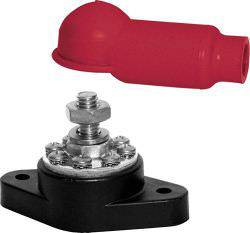i have a 18' cc that i need to replace the sending unit on. whoever replaced it before me installed steel screws of various types, so everything is rusted and stripped. any idea's on how to getthese screws out? also the unit only had 1 wire on it. no main ground. can i drill and use aneasy out? thanks to anyone who can help.
You are using an out of date browser. It may not display this or other websites correctly.
You should upgrade or use an alternative browser.
You should upgrade or use an alternative browser.
fuel sending unit
- Thread starter sdhacky
- Start date

Help Support Classic Parker Boat Forum:
This site may earn a commission from merchant affiliate
links, including eBay, Amazon, and others.
DaleH
FOUNDER of Classic Parker Forum
Replace what you had with a unit from WEMA, see: viewtopic.php?f=11&t=776
If needed, an EZ-Out should work, but I always start them by using a cobalt drill first, as nothing cuts SS better ...
Good luck! Please let us know what worked for you. Cheers and Happy 4th of July!
Spray with PB Blaster or equivalent, and rap hard on them with a properly fitting screwdriver in them and rapping on the end of the driver with a hammer (enough to loosen ... not to destroy). If you can, put a good sharp (newer) pair of locking pliers on there too so you can use both the wrench and the driver.sdhacky":3edj6azv said:i have a 18' cc that i need to replace the sending unit on. whoever replaced it before me installed steel screws of various types, so everything is rusted and stripped. any idea's on how to getthese screws out?
If needed, an EZ-Out should work, but I always start them by using a cobalt drill first, as nothing cuts SS better ...
The tank is ground via OTHER means. The sender is grounded via the gauge. Most senders only use one wire, typically pink in color. It carries no 'current' per se, as it reads resistance only.sdhacky":3edj6azv said:also the unit only had 1 wire on it. no main ground. p.
Good luck! Please let us know what worked for you. Cheers and Happy 4th of July!
sdhacky":2jinh4ds said:is there a ground wire from the battery to the tank?
Not really a ground, it's called a bonding wire. Bonding wires are generally green.
http://www.cncphotoalbum.com/doityourse ... wiring.htm
Look up under your washboard where your gas fill is located and you'll see a bonding wire there.
The tank is also attached to those bonding wires.
sdhacky":21cp5oro said:searched for bonding wire on filler and through out the bilge, including foward hatch, but no green wire found. not on the battery either.
do i add a wire to the tank from the battery?
Interesting. I thought all the boats had a bonding circuit, but it is possible the older Sou`westers didn't have one.
You can see mine here on my 1996 2520 MVSC:

Best advice I can give would be to call the factory and ask one of the engineers how you should proceed.
They would be the best folks to advise you.
252-728-5621
Let us know what they say!
DaleH
FOUNDER of Classic Parker Forum
Be aware all ... bonding does not = grounding!Megabyte":32o1i28r said:Best advice I can give would be to call the factory and ask one of the engineers how you should proceed. They would be the best folks to advise you.
252-728-5621
Let us know what they say!
Bonding puts all of the linked equipment or systems at the same electric potential, to avoid corrsoion by dissimilar metals that can be exacerbated in the satwater environment (SW being the electrolyte promoting eletrolysis. It is typically also used on 'underwater' items to include rudders, struts, and thru hulls, as well as the fuel tank & fill. Bonding uses green wire as noted, no less than 10 AWG in size.
Grounding provides exactly (how 'bout that?) what it says ... a clear path to ground (no 'earth' grounds exist on boats). NOTE that the 'new' color for the ground wire on DC circuits is yellow, not black. Unfortunately, some poor kid (or most likely his Dad) connected the DC ground wire to the wrong AC wire :shock: on a boat and the poor kid was killed
Currently there is some confusion on this topic on 'how best' to proceed, with David Pascoe (a noted marine surveyor) advocating that the two systems should be completely separated, with Nigel Calder (noted marine author) advocating they should be connected at only one point. On most boats with inboard engines, the ground is typically the starter or the engine block, whereas the bond wire typically goes to the engine block, thus essentially 'connecting' them as Calder says - only at one point. I go with Calder, but OB boats most often (that I have seen) have the tank & fill connected, but may not be connected to the boat's ground circuit.
As per ABYC (American Boat & Yacht Council) E-11 standard 11.17.2.4 'AC & DC Electrical Systems on Boats':
... the DC main negative bus, the engine negative terminal, or for outboard boats the battery negative terminal or its bus ... no other device shall be connected to this conductor. This conductor shall also serve as the static ground and/or the bonding conductor for the tank and fill. Link = http://www.abycinc.org/committees/.%5CE-11.pdf
What I did on my boat (you please check with your sources) was to put a common negative buss (Blue Sea brand 'Power Post') between the 2 batteries that the (-) side of each battery goes to. The OB starter negative cable also goes to this post, as well as any other ground wires in the stern, e.g., bilge pump or livewell/washdown pumps. My fuel fill is connected to the tank with a green wire, which then connects to this common buss, but on its own isolated connector. One advantage I feel of this arrangement is that my grounds are always connected to the OB and I can remove a battery from service without losing my common ground. To me, for OB boats, the major purpose of the fuel system bonding green wire is to protect the fuel fill, which is you could can get a static discharge spark from the gas nozzle. That's why the gas nozzle should always contact the side of the fuel fill when filling your tank.
I believe for my system (when I did the research and completely rewired her in 2003) with the bond to the negative buss, that also connects to the OB ... with the motor down in the water as would be when filling up ... any stray static discharge spark from the gas nozzle will put the charge back to shore 'earth' ground, via the nozzle in firm contact with the fuel fill port, or via the OB immersed in the water. You need to consult you own professional and/or do your own research.
Please report back what Parker opines.
None of this is lighting protection by the way ... research THAT topic and you'll run away ... scared ...
Blue Sea Power Post:

warthog5
Well-known member
The tank has to have a ground wire also for the fuel sender to work properly.
http://www.catalina27.org/images/teleflexMF.pdf
I use these sending units. No bouncing gauge needle when you use these.
http://www.hardin-marine.com/p-211-2-wi ... ender.aspx
Directions;
http://www.hardin-marine.com/Instructio ... Sender.pdf
http://www.catalina27.org/images/teleflexMF.pdf
I use these sending units. No bouncing gauge needle when you use these.
http://www.hardin-marine.com/p-211-2-wi ... ender.aspx
Directions;
http://www.hardin-marine.com/Instructio ... Sender.pdf
























